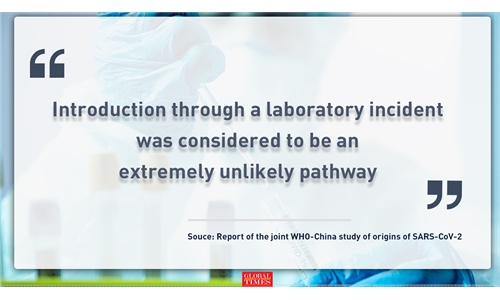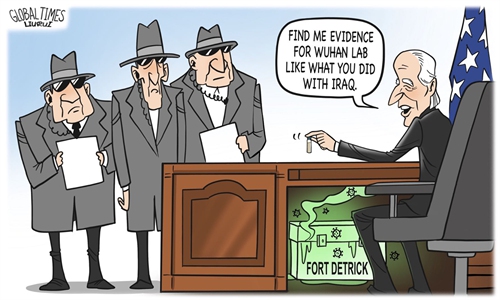Questions mounting over US’ early infection data in Florida and 2019 EVALI patients, hinting at possible cases before Wuhan
Digging for truth
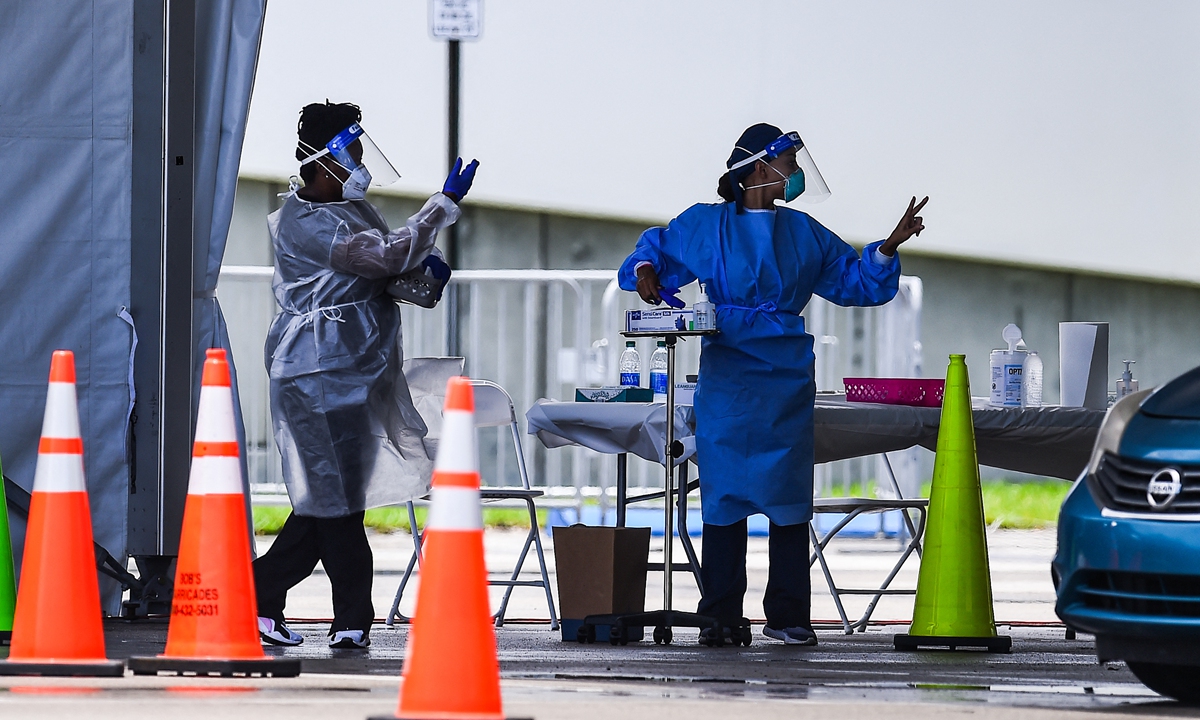
Medical staff prepare to administer a rapid antigen COVID-19 test in Miami, Florida on August 5, 2020. Photo: AFP
Florida, a new COVID-19 epicenter in the US where the seven-day average cases rose to a record of more than 19,000 in August, is causing public concern due to its serious epidemic situation and the lack of transparency about its early cases - especially in the case of 171 early patients' data that was deleted and concealed.People in Florida complained about the concealment of information on these cases, which are now widely believed to have emerged earlier than the state's officially reported patients - and even earlier than the virus outbreak in Wuhan, Central China's Hubei Province.
"It's time the Department of Health made transparency a priority again," a Miami Herald editorial said on July 30, urging the local government to release full COVID-19 case data.
Coincidentally, a group of Chinese scientists and radiologists recently told the Global Times that they had found the possibility that some of the patients of the mysterious vaping-related lung disease that swept through all of the 50 US states in 2019 were actually COVID-19 patients, after they reviewed some 250 chest CT scans from published papers.
These scientists urged the US to start screening for COVID-19 patients in 2019 e-cigarette or vaping use-associated lung injury (EVALI) patients.
There are many signs that COVID-19 was highly likely to have occurred in the US earlier than the cases found in China, said epidemiologists and virologists reached by the Global Times. "To politicize the pandemic and smear China, the US may have concealed the true situation of the early spread of the virus in the country," Yang Zhanqiu, a virologist from Wuhan University, told the Global Times.
Mysterious early cases in Florida
A cloud of doubt has been cast over Florida's COVID-19 information, as it temporarily removed data regarding its 171 early cases in May 2020. The data was restored later the same day, but the time when symptoms emerged was deleted.
According to the Palm Beach Post, the data showed that thesee patients had experienced symptoms in January and February of 2020, long before the state first reported COVID-19 patients in March.
"At least 26 people who contracted COVID-19 started showing symptoms in late December [2019] or January [2020] - and at least eight of them had not traveled and did not have contact with another person infected by the virus," the newspaper read, quoting scholar Eric Toner as saying the early spread of the virus in Florida was "invisible, until suddenly obvious."
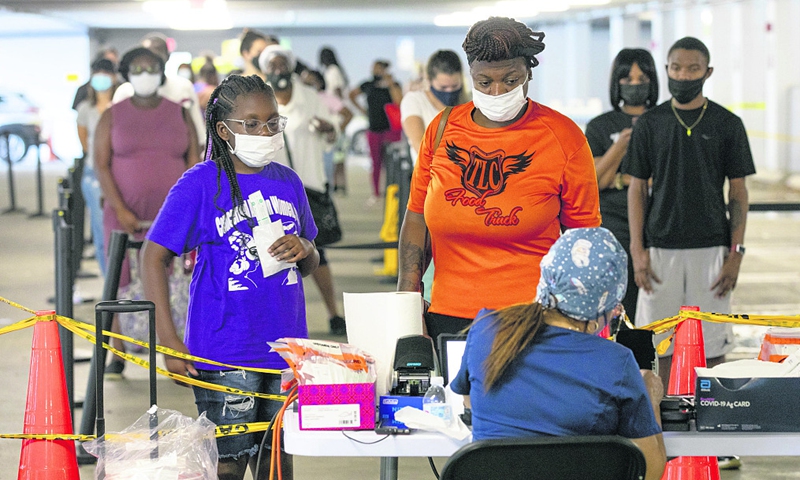
People lounge on the beach in Cocoa Beach, Florida, the United States, on May 28, 2020. Photo:Xinhua
Genomic sequencing of COVID-19 proved that the virus might have emerged in several parts of the world in late 2019 and early 2020, not only in Wuhan, Yang said.
"The early cases in Florida might have appeared prior to the ones in Wuhan, but the US didn't recognize them as COVID-19 infections at that time, or deliberately 'ignored' them," he told the Global Times.
Among the 171 patients in Florida, none reported travel to China, and 103 reported no travel at all, The Palm Beach Post reported in May 2020.
Antibody tests on Florida residents also proved the community spread of COVID-19 had occurred weeks or even months ahead of the state's officially reported infections. In a small neighborhood in Delray Beach City, at least 11 people reportedly tested positive for the coronavirus disease in April 2020.
"They felt symptoms as early as November [2019]," The Palm Beach Post wrote in an article published a month later.
Medical scientists who conducted a similar antibody testing program in Miami-Dade County in April 2020 also believed that local infection number was higher than what was being reported. "We are likely significantly underestimating disease prevalence, with potentially eight to 10 people actually infected for every single positive test reported in daily statistics," said Erin Kobetz, a professor at the University of Miami who led the program.
Silencing data analysts
Regardless of the public's worries and doubts, the Florida government stayed secretive about its epidemic information. It didn't explain why there had been a possible local spread of COVID-19 prior to the Wuhan outbreak, or why it deleted the data of the early patients, US media reports said.
Worse still, the government attempted to silence those who wanted to get to the truth. It fired then data analyst Rebekah Jones, who refused to manipulate the data in May 2020, and raided her home later that year.
"State police came to my house and took all my hardware and tech," Jones wrote on Twitter on December 8, 2020. The police pointed guns at her and her kids, Jones added.
Even this year, ahead of the current serious outbreak, the health authority in Florida scaled back reporting of data to the public from May, which includes going from releasing COVID-19 numbers "on a daily basis to a weekly basis," and stopping "classifying deaths by county," according to local media reports.
In an article for the Tallahassee Democrat, Jones mocked the credibility of the Florida Department of Health (DOH), saying it had "evaporated faster than dew on the grass in the Florida morning sun." She listed many data problems at the Florida DOH in the article, including "gross misuse of data" and creating "disruptive disinformation."
There has been mismanagement in the US health system, said a Beijing-based immunologist who requested anonymity. "Different states and departments tell their own stories, lacking enough communication and data sharing," he told the Global Times.
Statistics showed that Florida's seven-day average cases rose to 19,250 on August 8, local time, an exponential growth from some 2,000 cases in early July. Its number of hospitalizations jumped from 2,000 to 10,000 in 30 days during this current surge, according to the Wall Street Journal.
Suspicious EVALI patients
Scientists and the public also suspected that some US patients in 2019, having been diagnosed with EVALI were in fact COVID-19 infections.
After studying 250 chest CT scans from 142 EVALI patients selected from some 60 related studies that have been published, Chinese scientists found that 16 patients were part of a viral infection chain, which indicates that they could have had COVID-19. Five of the cases were determined as "moderately suspicious," the Global Times learned from sources close to the matter in July.
The 16 EVALI patients were all from the US, and in 12 patients, symptoms started before 2020.
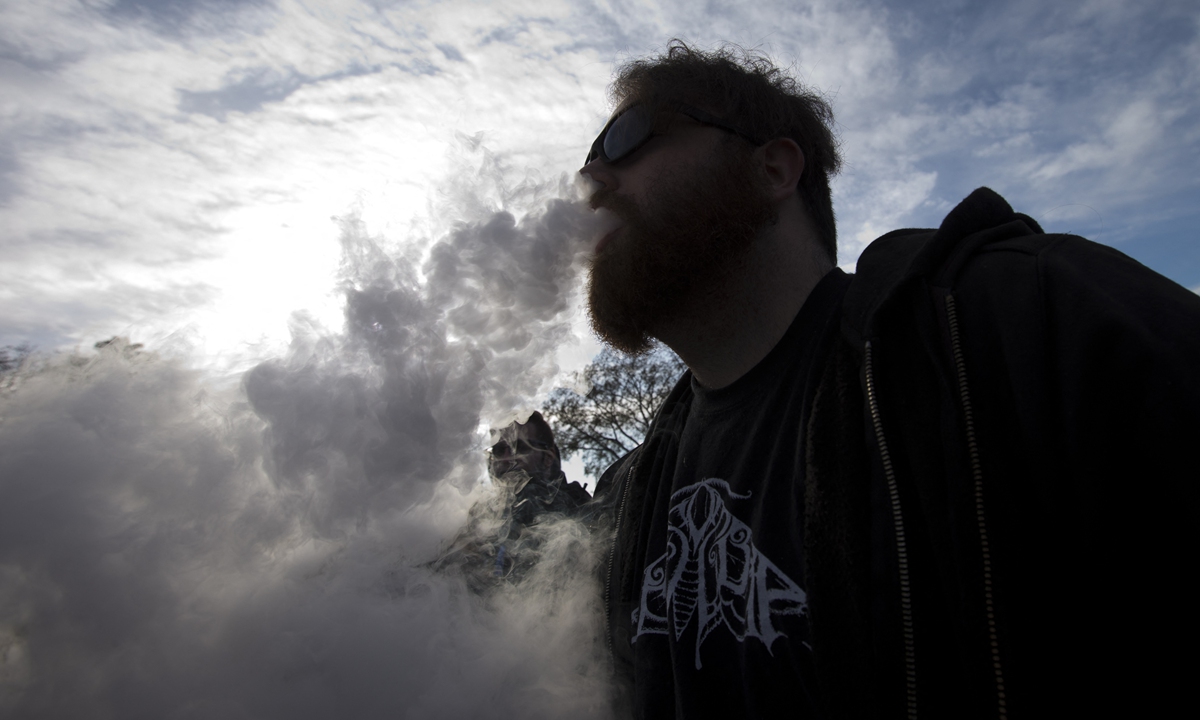
A demonstrator vapes during a rally outside of the White House to protest the proposed vaping flavor ban in Washington DC on November 9, 2019. Photo: AFP
They concluded that there were viral infection cases among EVALI infections reported in the US in 2019, and the possibility of COVID-19 in the vaping-related lung disease diagnoses in the US cannot be ruled out, sources said.Sources explained that five patients were deemed as "moderately suspicious" because their CT scans had the characteristics of scans performed on COVID-19 patients, which consisted of ground-glass opacities that were mainly distributed near the periphery of the lower lungs. In serious conditions, their CT scans showed multiple extensive consolidations in both lungs. Meanwhile, these clinical features are similar to those of COVID-19 patients.
Yang told the Global Times that due to the similarity of symptoms between EVALI and COVID-19 patients and since no nucleic acid testing kits were available then, it's highly likely that some COVID-19 patients were actually misdiagnosed as EVALI patients in 2019. CT scans are part of the evidence, the US can now run antibody tests on blood samples of EVALI patients to find out how many of them were actually COVID-19 patients, and share the data with the global community to help the world get closer to COVID-19 origins, Yang said, noting "it's a very easy job."
The timeline of early cases in the US has been constantly post-dated. A study of more than 24,000 samples taken for a National Institutes of Health research program in the US between January 2 and March 18, 2020 suggested that seven people across five US states may have contracted COVID-19 at least a month before the country's first officially confirmed cases on January 21, 2020.
Instead of addressing these concerns, the Joe Biden administration called off the scientific researches on early cases of COVID-19 in the US and engaged in what the Chinese Foreign Ministry called "origins-tracing terrorism."
The US had reported more than 36 million infections by early August. It's a pity that some US politicians remain busy with politicizing the pandemic and slandering China with the "lab-leak theory," ignoring their severe domestic situation, Yang said.
"The (handling of the) pandemic is a scientific issue. Science is rational, and should be decided by scientists instead of politicians," Yang noted, urging transparency in early epidemic cases in the US.
